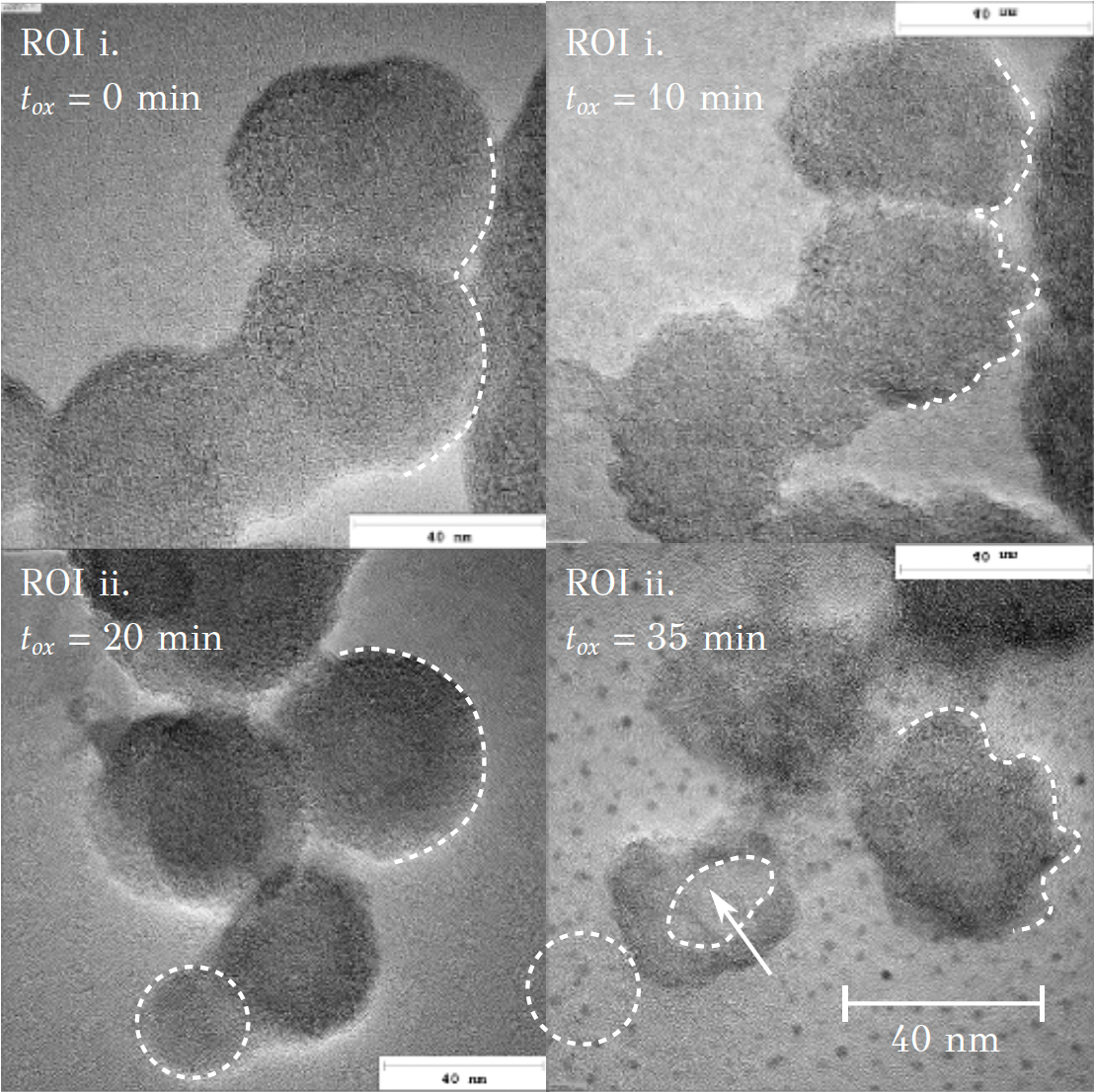Reactivity of particles from gasoline direct-injection engines: Correlation with particle properties and engine parameters.
The overarching objective of the research project funded by the German Research Foundation (DFG, project number 316493809) is to develop property-reactivity correlations. Further, the project focuses on the influence of engine operating parameters on soot from gasoline direct injection engines (GDI engines). Thus, the regeneration of particulate filters could be targeted by adhering to specific engine operating cycles. The first and second funding periods of the project are being carried out in cooperation with the Institute of Internal Combustion Engines (IFKM) and the Institute for Chemical Technology and Polymer Chemistry at Karlsruhe Institute of Technology (KIT). In the first funding period, synthesis of soot particles with different reactivities was realized in a GDI engine under different operating conditions. A comparison of soot particles from the GDI engine with those from model burners at elevated pressure and the modification of the particle reactivity by the engine operating conditions and/or the synthesis conditions, respectively, showed that with regard to reactivity, engine generated soot may be mimicked by particles from model burners. Furthermore, it was shown that by varying the engine operating parameters (engine speed, engine load, injection pressure, start of injection, ignition timing, equivalence ratio), soot reactivity can be influenced and controlled over a wide spectrum. Soot particles from the GDI engine as well as the model burners were ex situ characterized with respect to their reactivity, micro- and nanostructure, and other properties using a analytical toolbox (thermogravimetric analysis (TGA) coupled with mass spectrometry (MS) and Fourier transform infrared spectrometer (FTIR), gas chromatography coupled with MS (GC-MS), UV-VIS spectroscopy, high-resolution transmission electron microscopy (HRTEM) including pattern recognition algorithms, elemental analysis (EA), BET surface analysis via gas adsorption, energy-dispersive X-ray spectroscopy (EDXS), ...). Reactivity-property correlations were derived from experimentally determined reaction rates for oxidation with molecular oxygen and nanostructure analysis of primary particles, and validated over a wide range of parameters with different types of soot. The dominant property for reactivity was identified as the size of graphene layers embedded within primary particles. An approximately linear correlation was found between the size of graphene layers and a reactivity index.
Related literature on the aforementioned aspects:
- Soot nanoparticle sizing in counterflow flames using in situ particle sampling and differential mobility analysis verified with two-colour time-resolved laser-induced incandescence Hagen, F. P.; Vlavakis, P.; Seitz, M.; Klövekorn, T.; Bockhorn, H.; Suntz, R.; Trimis, D. 2022. Proceedings of the Combustion Institute. doi:10.1016/j.proci.2022.07.253
- Influence of Global Operating Parameters on the Reactivity of Soot Particles from Direct Injection Gasoline Engines Koch, S.; Hagen, F. P.; Büttner, L.; Hartmann, J.; Velji, A.; Kubach, H.; Koch, T.; Bockhorn, H.; Trimis, D.; Suntz, R. 2022. Emission Control Science and Technology, 8 (1-2), 9–35. doi:10.1007/s40825-022-00211-y
- Why Soot is not Alike Soot: A Molecular/Nanostructural Approach to Low Temperature Soot Oxidation Hagen, F.; Hardock, F.; Koch, S.; Sebbar, N.; Bockhorn, H.; Loukou, A.; Kubach, H.; Suntz, R.; Trimis, D.; Koch, T. 2021. Flow, turbulence and combustion, 106 (2), 295–329. doi:10.1007/s10494-020-00205-2
- Spark discharge-generated soot: Varying nanostructure and reactivity against oxidation with molecular oxygen by synthesis conditions Hagen, F. P.; Rinkenburger, A.; Günther, J.; Bockhorn, H.; Niessner, R.; Suntz, R.; Loukou, A.; Trimis, D.; Haisch, C. 2020. Journal of aerosol science, 143, Art.-Nr.: 105530. doi:10.1016/j.jaerosci.2020.105530
- Impact of the Injection Strategy on Soot Reactivity and Particle Properties of a GDI Engine Koch, S.; Kubach, H.; Velji, A.; Koch, T.; Hagen, F. P.; Bockhorn, H.; Loukou, A.; Trimis, D.; Suntz, R. 2020. WCX SAE World Congress Experience, Detroit, April 21-23, 2020. doi:10.4271/2020-01-0392
Another focus of research was the development of in situ laser-based diagnostics to confirm reactivity-property correlations from the nanostructure analysis. For this purpose, the refractive-index functions for absorption of different particles and their ratio at several wavelengths were determined. Applied methods were UV-VIS spectroscopy and two-color time-resolved laser-induced incandescence (2C-TiRe-LII) at three different excitation wavelengths (3λ-2C-TiRe-LII). Approximately linear relationships of the ratios of the refractive-index functions for absorption at different wavelengths with the size of graphene layers were found, resulting in correlations of these ratios with soot reactivity as well. As an in situ optical diagnostics, the determination of refractive-index functions for absorption may also shed light on reactivity of soot particles during their formation in the engine and post-oxidation in the exhaust tract, thus characterizing these particles with respect to their oxidation behavior during particulate filter regeneration.
Related literature on the aforementioned aspects:
- From molecular to sub-μm scale: The interplay of precursor concentrations, primary particle size, and carbon nanostructure during soot formation in counter-flow diffusion flames Hagen, F. P.; Vlavakis, P.; Bockhorn, H.; Suntz, R.; Trimis, D. 2023. Combustion and Flame, Article no: 112729. doi:10.1016/j.combustflame.2023.112729
- Carbon nanostructure and reactivity of soot particles from non-intrusive methods based on UV-VIS spectroscopy and time-resolved laser-induced incandescence Hagen, F. P.; Kretzler, D.; Häber, T.; Bockhorn, H.; Suntz, R.; Trimis, D. 2021. Carbon, 182, 634–654. doi:10.1016/j.carbon.2021.06.006
Based on the preliminary work, the aim of the second funding period was to deepen the fundamental knowledge gained about the property-reactivity correlations. Previously unaddressed issues such as the role of aromatic and oxygenated fuel components were to be investigated and the kinetic approaches obtained from the experiments were to be incorporated into physicochemical-based models for application in particulate filters. As known from previous work, soot reactivity changes during oxidation. To further clarify these issues, the nanostructural properties of soot particles should be tracked ex situ. This should enable the programmability of soot reactivity using engine operating parameters and the control of the regeneration behavior of particulate filters.
Related literature on the aforementioned aspects:
- Nanostructural and morphological characteristics of single soot aggregates during low-temperature oxidation Hagen, F. P.; Bockhorn, H.; Störmer, H.; Loukou, A.; Suntz, R.; Trimis, D. 2021. Proceedings of the Combustion Institute, 38 (1), 1153–1161. doi:10.1016/j.proci.2020.06.338

The nanostructural properties identified as crucial for reactivity (size of graphene layers) are to be in situ monitored during formation and post-oxidation of the particles in the engine and exhaust tract using optical methods. Based on the 3λ-2C-TiRe-LII, the dual-pulse time-resolved laser-induced incandescence (DP-TiRe-LII) was developed. This laser-based diagnostics enables a non-intrusive and fast quantification of the refractive-index function for absorption of transient and inhomogeneous aerosols. The primary particle size distribution can also be measured. The DP-TiRe-LII has been successfully tested for non-intrusive determination of soot reactivity from transient and steady-state operating points of a GDI engine upstream of the particulate filter.
Related literature on the aforementioned aspects:
- Dual-pulse laser-induced incandescence to quantify carbon nanostructure and related soot particle properties in transient flows – Concept and exploratory study Hagen, F. P.; Suntz, R.; Bockhorn, H.; Trimis, D. 2022. Combustion and flame, 243, Art.Nr. 112020. doi:10.1016/j.combustflame.2022.112020
- On-line monitoring of carbon nanostructure and soot reactivity in engine exhaust by dual-pulse laser-induced incandescence Hagen, F. P.; Kretzler, D.; Koch, S.; Bockhorn, H.; Suntz, R.; Trimis, D.; Kubach, H.; Velji, A.; Koch, T. 2023. Combustion and Flame, 254, Art.-Nr.: 112850. doi:10.1016/j.combustflame.2023.112850

